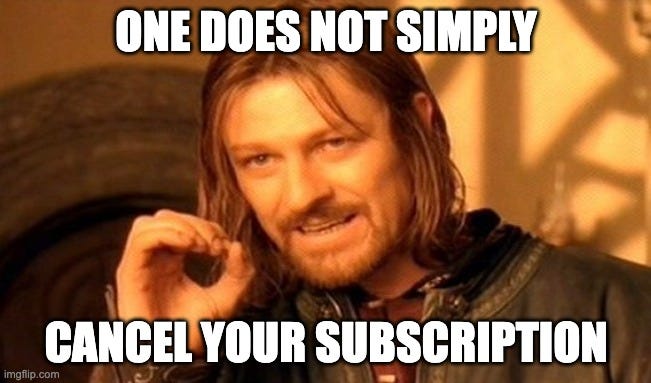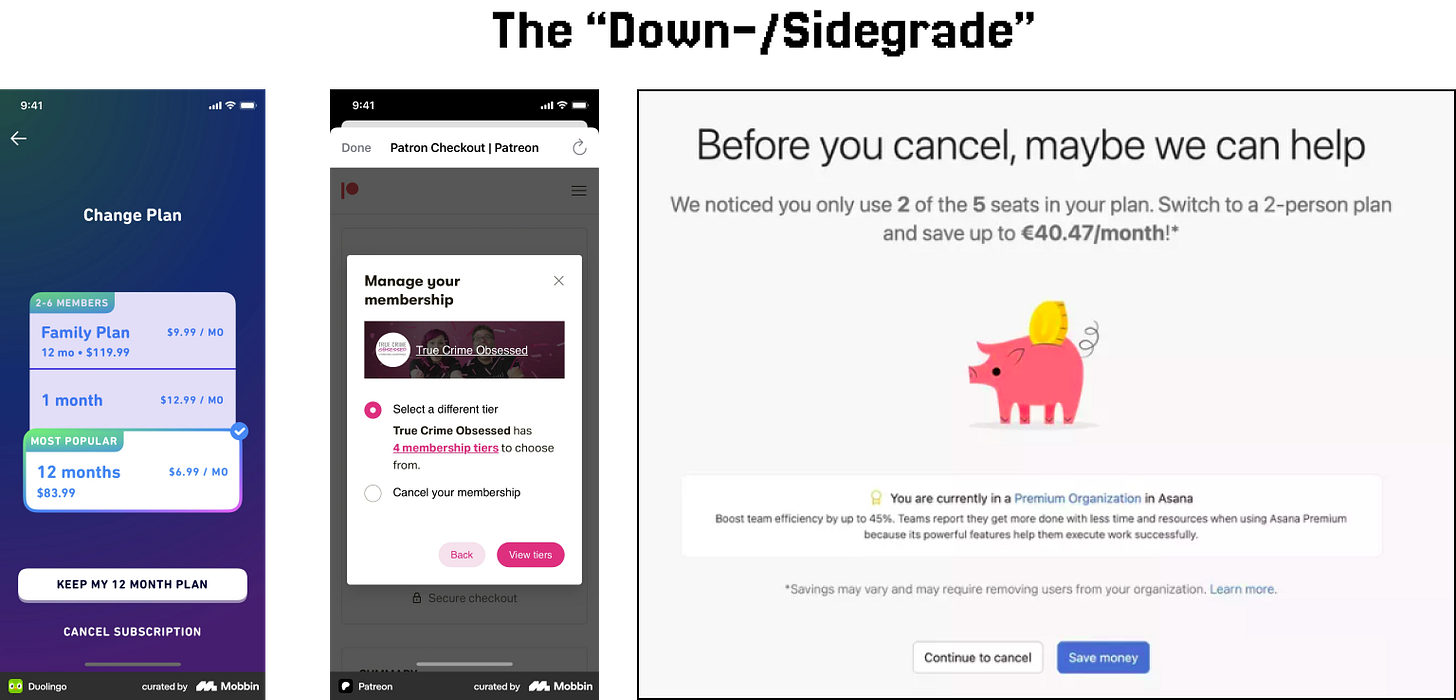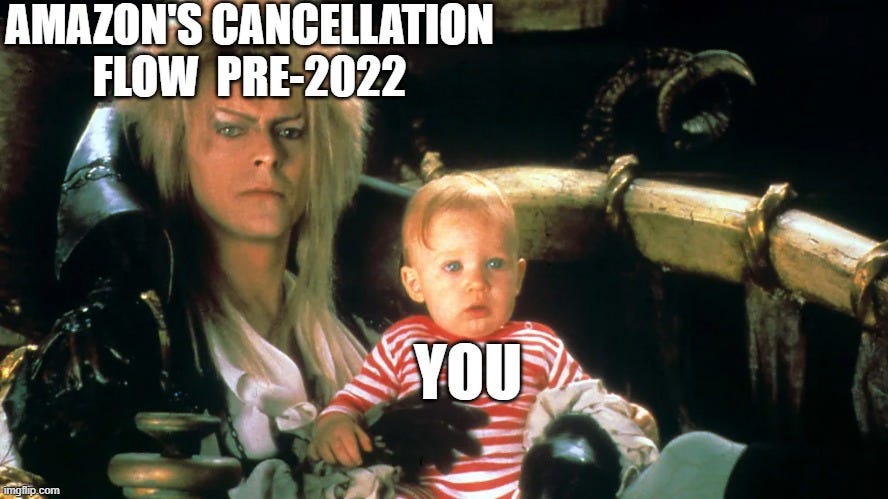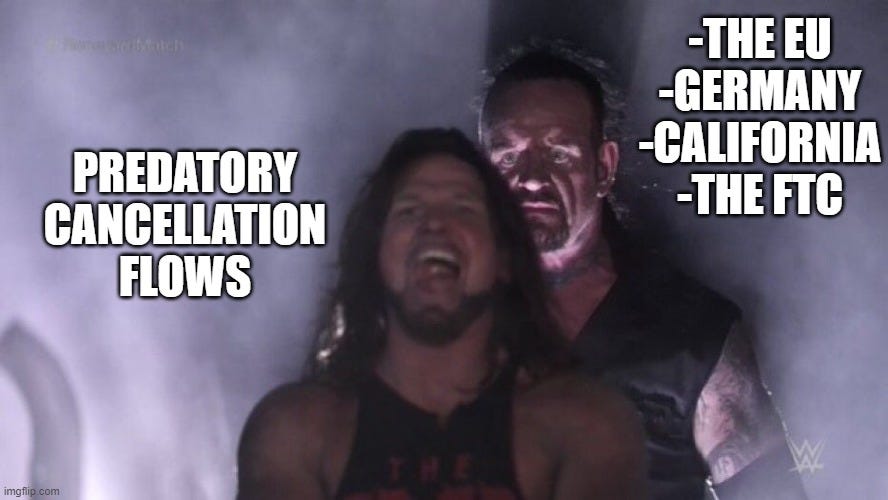Cancellation flows 101 - How to improve retention without selling your soul (and burning your reputation)
A "growth hack" that *might* be right for you
LAST MINUTE NOTE→ on the October 16 2024 ruling by the FTC ‘Click to cancel’. The article content is still valid, but this could be a significant development going forward depending on further context, commentary and rulings.
See appendix note below for more
You’ve just signed up to a new product with a trial.
You always seem to forget to cancel those, so naturally, you navigate to the “Profile/Settings” area to manage your subscription - you want the “Cancel” action.
Can’t find it.
You suspect they hid it on purpose.
Buried within a nearly impenetrable labyrinth of screens - you find the button of power to prevent you from losing $50 (again).
Now the true test begins.
The… Cancellation Flow.
Step after step of swapped button placements and colours, repeating a very similar rewording of “Are you... really sure you’re sure?”, wearing down your rapidly depleting willpower until you get some unrelated notificat-
*PING*
Ah yes I had to get back to whats-their-name about whats-that-thing.
Let’s take care of that now… done. And what was doing again?
I’ll cancel this later.
(You won’t, but you’ll probably complain to your friends/partner/cat that it was too hard to cancel)
What are they, and why are they used?
One of the most common “growth/retention hacks” is the attempt to intercept the customer on their path to cancellation and change their mind. At this point, if you’ve got nothing to alter their course, there’s a near-100% chance you’ve lost a customer.
You see them almost everywhere in the B2C world, and even some areas of B2B (especially the “Prosumer*” segment).
Because.
They.
🌈✨Work✨🌈
*Prosumer: Targeted at serious, enthusiastic consumers, incorporating professional features but often modified for non-professional use. (wiki)
Why do they work?
We hate friction. As is the case with activating new users, the greater the non-valuable friction is, the fewer will be successful with your product. The same is true for cancellation → fewer will complete the action, but it’s important that we keep this friction in good-faith.
We love a good deal. If you offer an outgoing customer a juicy deal, it can be hard to say no. 50% off for the same value will cause most to re-think their choice.
It’s relatively easy work for the gain. The alternative → add new features, products, or improving the new user experience is a tough job that’s never really done, and can take 3-6 months to build up learnings and wins in a new area.
The moment of the customer initiating the cancellation process is absolutely decisive.
If you wait until AFTER they cancel, the post-cancellation resurrection success rates are in my experience in the (very) low single digits if you’re lucky.
My teams have implemented these flows in a couple of different products - to great effect - and I’ve looked at a LOT of examples so you don’t have to.
There are a few catches though:
They aren’t for every product/industry
The “addressable canceller” share for Mobile Apple/Google store subscribers is low (because they tend to cancel directly in the respective stores).
They shouldn’t be the first tool to reach for, since there’s typically a mountain sized opportunity in improving activation to prevent cancellation actions in the first place (“Growth through Activation” covered in future issues of the newsletter)
What we cover here
Common cancellation flow steps, what they’re for and when to use them
Good examples to sample from
How hard is too hard?
Does a cancellation flow make sense for me?
The “Mobile problem”
Is it technically feasible?
1) The common cancellation flow steps
Note that many of the screenshots in this article were sourced from Mobbin, an excellent User Flow sampling tool, which is super useful for inspiration & research.
If you’re interested, you can get 20% off your first billing cycle of the Pro plan here. (Disclosure: I get $10 of Mobbin credit for successful referrals)
The “Survey”
One of the most common steps, and for good reasons.
Source of data about why customers cancel. This is the best time to get this information, since emailing them later will have a much lower success rate, and the reason is the most fresh in their mind right now.
Note: If you’re including a “Price” related question, it’s highly likely this will be the most selected one. This can mean a lot of things outside of purely “price”. They subscribed at that price in the first place, so it’s theoretically affordable, but the actual value received over time wasn’t sufficient to justify continuing. (It’s of course possible for the financial situation of someone to change over time, but most of the time I believe it’s more value related)
Friction. It’s a process interrupt that can make someone reflect on how they really feel.
Versatile. Valuable for most use-cases, not that dependent on industry or target customer.
Tips:
Maximum 5-7 options, fewer is better imo, especially if you’re lacking insights yet on the main reasons
Allow an “Other” with a text answer for them to give you more information.
Keep it optional → In my opinion if you want higher quality data, don’t force them to share. Either skippable or a “Prefer not to say” option
Alternatively, you can go the Netflix route and show this screen after the cancellation is confirmed. You trade “friction” for even higher quality data.
Here’s a decent article from Userpilot’s blog on the topic - Note this is more related to a survey the user can complete in their own time, but I feel the insights they recommend focusing on are valuable.
The “Discount Offer”
Fairly common in the B2C world, where the end user is also the buyer, and decisions are more made on impulse.
It’s a last-ditch effort to save a customer that’s already highly motivated to replace you (or already has and you don’t know it yet).
It’s a reward for the least loyal, and it can be highly effective in the right situation, for the right type of customer.
I’m talking >10% customers saved in a good case.
Problems:
Not suitable for all segments (See below)
If you’re too aggressive with discounting in general, this can erode the value of your product over time.
Tying into 2. above, word might get out about your cancellation/discount policy.
Note: I haven’t personally noticed increases in users intentionally canceling to trigger a discount since implementing the cancellation flows themselves. The thinking is that someone will share the fact there’s a deal, then more start to check even without the original intent to cancel, but I haven’t seen evidence of this on a significant scale)
What kinds of customer segment does this make sense for?
B2C - Highly suitable
Customer is paying out of their own pocket, decisions about their own life can also be highly emotional. We’re a lot more susceptible to impulse buys than a multi-user team.
B2B Prosumer (Individual users but professional use-case)
Fairly suitable, situationally dependent. Often they’re paying out of their own pocket, are more price conscious which can make them work.
I would be more careful about the size and frequency of discount, since if you’re targeting the Prosumer segment, you’re also likely eventually looking up-market to expand into larger accounts.
B2B Startup+
I don’t think it makes a lot of sense. The decision is more of a collective one, and if they’re cancelling, they’ve likely already vetted and implemented an alternative.
It’s more often a better strategy to focus on increasing value of the product over time, to then be able to justify higher prices amongst those willing and able to pay, rather than pursue every possible customer with an aggressive discount strategy.
The “Value reminder”
A personal favourite of mine, the “Value reminder” is constantly evolving in the world of cancellation flows, and a tactic that can be employed either:
Within the flow itself.
Before the cancellation starts
We can see it used to great effect in Canva in-flow, who show you how much you’ve used which premium features over time.
I’m a big fan of this implementation, because with some products it can also be confusing what is/isn’t included in the free plan. In this way they give more certainty about what you lose while simultaneously reminding you of the value you’ve gotten. 💡
The second option is working this value display into area where the user would normally initiate cancellation.
A highly effective example of my Wolt account (Food delivery). The core value prop of Wolt+ is saving money on delivery, and that is on clear display here.
Why would I cancel their €40 subscription when I can see saved me already €200 over the past 7 months?
Prompt: What is the core value that you’re delivering, and how might you remind the customer of that as they’re considering their option to cancel?
The “Down-/Sidegrade”
If it’s done well: Appealing to the customer’s lack of awareness of other plan tiers. It could be that they’re subscribed to a plan that has more than they need, and a lower plan holds better value for them.
If it feels there just because: Friction for friction’s sake
I particularly like Asana’s approach (the example below on the most-right), since they can offer a plan that better fits the value delivered.
The “Pause”
Sometimes customers want to cancel due to only having an intermittent need, and in this case, the Pause can make some sense. E.g. a B2C gym membership, and I’m going on holiday for a few weeks, or a B2B Prosumer design tool which is used on a project basis.
If this sounds like your product, then this can definitely be a good choice. Below is an example from Bloom, an investing app where they try to sell the value of the pause with loss aversion → The customer can take a break without having to sell all of their stocks, and can resume in the future without any hassle.
The “Are you sure you’re sure?”
When there’s a double up of very similar steps, it’s hard not to think they’re there purely for friction.
I’d advise against these kinds of patterns when you have nothing substantial to show or give customers.
Duolingo gets a begrudging pass from me on Step 1 here, since this example is of a trial user, and it’s super common for people to cancel immediately simply to avoid getting charged without their consent in case they forget.
Truebill however, a product that is there to help you manage costs from your subscriptions, gets too close to a step duplication in my opinion. Oh, the irony…
2) Good examples to sample from
B2C mobile - Duolingo
They start with “Change Plan”, which is a way to introduce Down-/Sidegrade naturally into the flow
Survey
(If Trial) - Trial Reminder Reminder → Because many users try to cancel ‘cause they know they’ll forget.
Are you sure you’re sure? (not a big fan)
Done ✅
B2B SMB/Prosumer - Canva
A great example of clear, quick, respectful.
Value reminder
Survey
Done ✅
Post-cancellation qualitative feedback/suggestions
A nice collection of cancellation flows to sample from, by Khushi Lunkad on the Figma community→ https://www.figma.com/community/file/1343077677230477273
3) How hard is too hard?
When your flow is named internally “The Iliad Flow” after the Homerian Greek epic about the long arduous Trojan War”, you might just be the bad guys.
The cancellation flow is a part of your product experience, and you should therefore treat outgoing customers as well as your incoming ones.
Why? They won’t be paying us anymore!
This is a short-sighted view.
Because people remember. And people talk.
Too many people think that “churned” means “eternally vanish from this plane of existence”.
Have you ever checked your re-activation numbers before? If you’ve been looking at your customer lifecycle as a flat funnel with a beginning and end, you’re missing the big picture → that many customers re-activate, churn again, re-re-activate, and so on.
Even if it wasn’t a perfect fit for them perpetually, they might need you again in the future.
Or, it might be a perfect fit for someone they know.
We are highly social creatures, and we talk about stuff. We can also be petty and spiteful (speaking completely for myself here). If I feel like I’m getting screwed over, you better BELIEVE if I hear that name mentioned, or someone asked about my day, that I’m going to tell you about it.
If you handle your cancellations with grace, and they had a mostly positive experience, they could still recommend you to connections of theirs in the future.
It’s a different story if you’re holding a (near) monopoly.
There’s a reason why Apple hasn’t added date-range export for Offer Code redemptions in Appstore Connect, YouTube will continue stacking ads until we’ve come full-circle back to the “TV days”, and Amazon pre-2022 required you to recite 1000 digits of pi to cancel.
What are you going to do about it as an individual? Nothing.
Well that’s not entirely true → you can complain to your local consumer authority 😈
Because Consumer Protection
In researching this article, I tried to cancel my Amazon Prime subscription. It was shockingly straightforward. What happened to the Ninja Warrior obstacle course of dark-pattern f*ckery?
I naively theorised that the marginal gains of ever-worsening cancellation flows weren’t worth the long-term negative impact, so they voluntarily made it easier 😂. (Because there’s a reason why products competing in healthy markets treat you well → they have to to survive).
It wasn’t competition pressure, rather, the EU that forced Amazon to shorten and simplify the aforementioned “Iliad Flow”.
Another notable example is Adobe, which the FTC took action against this year. The assessment is fairly damning:
“Adobe trapped customers into year-long subscriptions through hidden early termination fees and numerous cancellation hurdles…”
Just. Don’t. Do it.
LAST MINUTE NOTE: On the October 16 2024 ruling by the FTC ‘Click to cancel’, this could change the game for what is/isn’t allowed, but I haven’t had time to properly digest it. Fortunately, those with actual legal experience have done so, see appendix link below.
Are we making it too hard? My rule of thumb
It’s simple: “Would I feel frustrated going through this?”
It will keep you on the right side of karma, and the law*.
*This is not legal advice 👩🏻⚖️
4) Does a cancellation flow make sense for my product?
Eventually, I believe most digital products should have one.
Firstly, this should come after significant work has been done into ensuring
Different steps make sense for different industries, as mentioned prior. If you’ve got a B2B team-focused product, then a discount offer doesn’t make sense, but in all cases a survey, and “Value Reminder” design is going to provide value.
If you’re a mobile app using Appstore/Playstore as a significant source of subscriptions, then there is more to consider.
The “Mobile” problem
If Apple Appstore or Google Playstore are a main subscription source for you, then this makes things a little more tricky. All mobile subscriptions need to be canceled in the context of the store, and it’s also the “default” place to go to initiate cancellation for most customers.
In my experience, even if you have a “Settings/Profile” area with a “Manage/Cancel subscription" button, easily over half of mobile cancellations will happen without any interaction with your Settings/Profile area.
This number goes way up when talking about recently initiated trials.
For products with a trial, there’s a huge spike in cancellations in the first 1-5 minutes after trial start (those who don’t want to forget / are just using trial for something temporary), and a vanishingly small fraction of those will turn it back on.
So is it worth it for my mobile app?
It absolutely can be.
But whether it makes sense for you now depends on many factors.
Have you already heavily invested in Onboarding & Activation of new users?
Preventing new customers from wanting to cancel in the first place is the right focus most of the time.
By ensuring they have a great first impression, onboarding, all the way into forming a routine is something I strongly recommend exploring before looking for the growth “hacks”.
Do you have a significant “addressable share” of users?
By “Addressable share” I mean the % of cancelling users who initiate through a touchpoint that you control e.g. settings/account area in your app.
This is useful for understanding how many more users you might be able to funnel into your cancellation flow.
I’d highly recommend checking the following data for the past month:
How many cancellations did you get? (Not the # of subscriptions that expired, but rather the # of customers who turned off auto-renew)
How many unique users started their cancellation journey from inside your app i.e. tapped on “manage your subscription” or “cancel”.
Addressable share = (Unique users tapping ‘cancel’ ) / (# of cancellations)
While you can directly measure the absolute # of “addressable cancellers” by the unique “cancel” taps, knowing the share gives us a baseline for trying to push that number up also.
Is it technically feasible?
If you want to offer a discount step on mobile, it can be a significant effort, especially if you haven’t got a full-stack team who can implement everything for you. In my experience the solutions Apple provide for this are far from ideal, full of manual work (Promotional Offers, Offer Codes), but Google is more flexible since rolling out their v2 subscriptions a couple years ago.
Thankfully, there are now products popping up offering plug & play cancellation solutions e.g., Raaft, ChurnKey to name a couple. I haven’t got first hand experience with these to confirm their limitations, nor are they sponsoring me, but they’re out there.
Putting it together
Let’s take a few scenarios:
If only 10% cancel starting in your app, then it’s likely there isn’t a large opportunity to be captured yet → You might experiment with encouraging more to initiate cancel in-app
If 40% cancel start in your app, the opportunity to be captured is decent, and we can try to divert more users towards the flow after building it → You might build the flow first, then encourage more to initiate in-app
If 70% already cancel in-app, then opportunity is high, but the opportunity to get more users in there might not be as high → You might just build the flow
Summary
Cancellation flows can be high impact growth lever, especially for B2C, and especially after you’ve gotten good at activating new users and making them successful
For Mobile, there are significant catches when considering a discount step, like the share of users cancelling in-app and the feasibility of implementation
Treat your offboarding like any other part of your customer experience, with respect and care
Please don’t build the “Iliad Flow”🙏🏻😭
Thanks so much for reading, and I hope you got some valuable insights to take away 💡
What’s next?
Growth + Impact model series → Understanding leverage to drive impact
Perhaps the most important job for anyone making Product or Growth decisions, is deciding “where can we have the most impact?”. You might have seen a super cool design/idea in the wild that you’re excited about, but will it move the needle the most?
I love exploring these questions, and will reveal my findings over the next few episodes, in different levels of depth/complexity.
Appendix
[1]Note on the October 2024 ruling by the FTC ‘Click to cancel’
Source for below: https://advertisinglaw.fkks.com/post/102jly9/click-to-cancel-is-here-as-ftc-announces-final-negative-option-rule.
Cancellation. Sellers must provide a simple cancellation mechanism, i.e., one that is “at least as easy to use” and available through the same medium as the mechanism the consumer used to consent to the negative option feature. The rule specifies the different minimum requirements for this “simple cancellation mechanism” for various media (online, phone and in person). Notably, for online cancellations, the rule states that “[i]n no event shall a consumer be required to interact with a live or virtual representative (such as a chatbot) to cancel if the consumer did not do so to consent.” And for in-person cancellations, an online or telephonic method of cancellation must also be available.
One thing is crystal clear → No more “Talk to an agent” to cancel, unless that’s how the customer signed up in the first place.
“At least as easy to use” could be open for wider interpretation, but this is all the more reason to design these flows ethically (without repeat steps, confusing design etc.).













